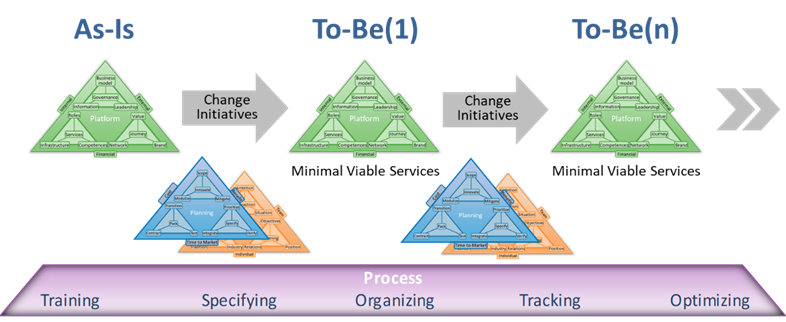
Summary
The fourth dimension, the Process Dimension, will tie the three other dimensions together. Without a strong Process for executing the business transformation, the other dimensions are worthless. Business transformation is a perpetual activity, so it is essential to train the organisation in change. The transformation must follow the same script in each workshop, and there must be a firm, reusable work package structure. This will enable training of the whole organisation in executing change, while the reuse of work packages will ensure that organisational learning is captured.
The Agile Transformation is defined by the sprints. Each sprint will create a new generation of the Business Platform. The sprint must be planned to deliver one or more Minimal Viable Services. The change initiatives are executed by adding planning, people and change processes.
The Process Dimension contains of 5 Disciplines. The Disciplines represent the necessary skills to master
the Business Transformation. All Disciplines are valid for a sprint, and they must be exercised as a part of the sprint.
The 5 Disciplines of the Process Dimension are:
| Organising | Defining the roles in the transformation organisation |
| Training | Training the organization in business transformation and in the technologies, that may be needed in the disrupted business |
| Tracking | Ensuring two-way traceability from strategy and scope to delivered capabilities |
| Specifying | Describing how to get from as-is to to-be |
| Optimizing | Include organizational learning to refine business fit and change organizational culture and ability |
Organise Discipline
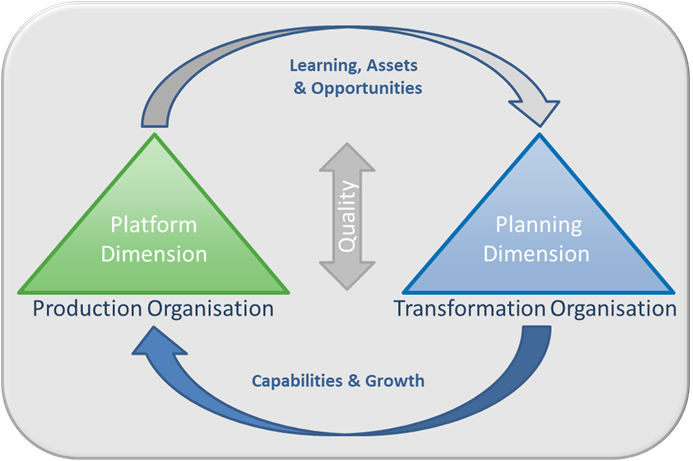
The 4Dimensions™ Transformation Framework only focuses on the Transformation Organisation – it is not intended for the Operational Organisation.
The Organise Discipline includes the staffing of the transformation organisation before, during and after the transformation.
Before the sprint
Most organisations have a clear focus on cost efficiency. Staffing costs are constantly monitored and most businesses function with a limited head count. The head count limitations are enforced by rigid hiring governance procedures.
To establish a solid foundation for a Business Transformation, key staff must be released from their normal duties. Well ahead of the start of the project, the management must ensure backfilling of these Subject Matter Experts – for example, by hiring in temporary replacements.
The Dual Mode Organisation concept is mainly focused on transformations run by the Rational or Administrative Approaches to the Planning Dimension, while backfilling is a necessity for all projects!
When a change project is started, Subject Matter Experts from the Production Organisation will have to do their operational job in parallel with the project. In all businesses, eminent production issues and work takes priority over future business. This results in inadequate staffing of the project and slow progress. Solving this problem is normally delegated to the Project Manager, and it is a highly-rated competence if Project Managers can get busy Subject Matter Experts to work on a project ‘below the radar’. All this work behind the scene adds to the Project Manager’s workload. At management level, it is difficult to understand why project management is 20% or more of the total staffing cost. A significant part of this time is spent on allocating staff and rearranging delayed activities due to staffing issues.
It is very uncommon that a project budget contains the cost for Subject Matter Experts from the Production Organisation. Normally, it only contains the IT effort. A rule of thumb is that the non-IT effort is the same as the IT effort. Therefore, a change with an IT effort estimated at 10,000 hours (including subcontractors) will require a business effort of 10,000 hours too!
During the sprint
Roles for the 6 Transformation Principles
The sequence of the principles reflects the organisational hierarchy’s responsibilities, where #1 resides with the top management and #6 resides at the operational level; Subject Matter Experts and Project Managers.
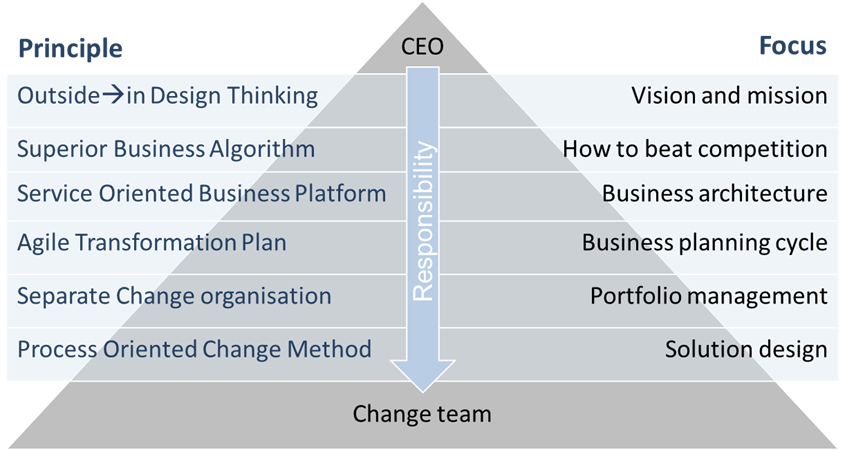
This will employ the following roles:
- The mission and vision will be decided by the CEO and approved at board level.
- The CEO and the Senior Management team will work out the Business Algorithm.
- The Service Hierarchy as well as the Business Architecture will need a specialised (new) role as Business Architect.
- The Minimal Viable Service will be determined by market, product and customer responsibilities.
- The CEO will be accountable for and point of escalation for issues. The day to day responsibility for management of the transformation with can be delegated to a Responsible Senior Executive.
- The specification of assets and actions will be delegated to the Subject Matter Experts.
It is important that the Responsible Senior Executive takes active ownership on ensuring that the deliverables of all the 6 Transformation Principles – the role is not an escalation point but an active driver in the Transformation Meetings.
To create the high-performance Transformation Team, it is important to establish knowledge and empower the Subject Matter Experts to use their knowledge in the decision-making process. It is also relevant to obtain diversity in competences by assigning external expertise.
Change is a corporate lifestyle. Genuine Change Managers and highly skilled Subject Matter Experts that are needed for an innovative and successful transformation will not thrive in static situations. Those people are travellers, and unlike settlers, they live for the adrenaline kick of new challenges and forced learning. These people will only strive in the Transformation Organisation. Therefore, the Transformation Team will be ready for recruitment for another change – or in another company after each sprint.
Roles for enabling of the Platform Dimension
The Platform Dimension also implies responsibilities; there must be appointed responsibles for Perspectives, Views, Themes and the Controls.
Roles for enabling of the Planning Dimension
The activities in the Plan Dimension require highly specialised competences. There must be appointed Subject Matter Experts for these roles. The manager of the transformation must be able to apply different leadership styles (People Approaches) in the different perspectives.
Some Specialised Roles for Business Transformation
Many roles are well defined in program and Project Management. There is no need to recap these. However, running business transformation requires some new ones.
Transformation Manager
The Transformation Manager is a central leader who reports directly to the CEO. The Transformation Manager is a C-level role with responsibility for the activities not in the Target Perspective but also of the success of the transformation. The Transformation Manager will own the Platform Plan and the roadmap of the sprints going forward. The Transformation Manager will also manage the portfolio of new capabilities and identify the Must-Win Battles.
The Transformation Manager is responsible for the organisation’s performance according to the overall objectives: A Fast, Agile and Repeatable Transformation.
The Transformation Manager role will require a Portfolio Manager background.
Business Architect
The Business Architect (role) is responsible for designing the delivery system for the value chain of the business. This is a part of the Modulise Theme in the Target Perspective. The Business Architect will Organise the business model by specifying the Business Modules needed to deliver the capabilities. This not only includes organising the business, but also creating the legal framework with suppliers, customers, partners and service providers (outsourcing).
Together with the Transformation Manager, the Business Architect creates the framework of the change component that needs to be executed by the Must-Win Battles to obtain the capabilities.
The key tasks are:
- Define roles in the value stream
- Define Business’s Business Modules
- Define Business Process Hierarchy
- Create cross-value chain organizational structures and road map
- Define Controls for processes and legal framework
Sourcing Manager
The Sourcing Manager is responsible for staffing the whole Transition Process. The Sourcing Manager will constantly be looking six months ahead to estimate the need for competences for all the disciplines of the change. The process must identify the Subject Matter Experts needed for the Business Transformation. Normally, the Subject Matter Experts are key staff members and very difficult to miss in the operations. Together with the Subject Matter Expert’s line manager, the Sourcing Manager must create backfilling plans, so the Subject Matter Experts can be made available for the change projects.
To avoid critical resource shortages, the Sourcing Manager is authorised to source external resources. Planning in advance for the staffing resources that might be required in the future necessitates great insight and forward thinking on the part of the Sourcing Manager. It also requires great coordination skills, as the Sourcing Manager must work closely with various other managers and help them address the issues pertaining to their staffing-related requirements.
Transition Manager
The Transition Manager is responsible for implementing the initiatives.
The Transition Manager tasks include:
- Internal communication
- User training
- User acceptance testing and end-to-end testing
- Synchronizing external communication
Subject Matter Expert
Subject Matter Experts hold detailed knowledge on how to run the business. The Business Architect may involve Subject Matter Experts in the design of the process hierarchy and definition of the Controls. They are responsible for imparting much-needed knowledge about the specific subject to the Business Architect and other people involved.
Work Package Owner
The Work Package Owner is responsible for delivering a Work Package. The role is a coordination role with the responsibility for delivering each step in a work package description.
Work Package Owners will generally be Subject Matter Experts, Business Analysts, Theme Owners or Process Owners. When work packages are grouped into tracks, Work Package Owners will become track leads.
The Work Package Owner will coordinate the delivery of the work package and to a very large extent be the practical driver in each of the steps in the work package. It is a role that requires meticulous and efficient coordination at each stage and for each work package.
Right Sizing Change
The Planning Approach depends the complexity of innovation. Disruptive innovation will require a Rational Approach while minor changes can be executed by using a Quick Fix Approach.
The analysis can vary in depth. A rule of thumb is shown below.
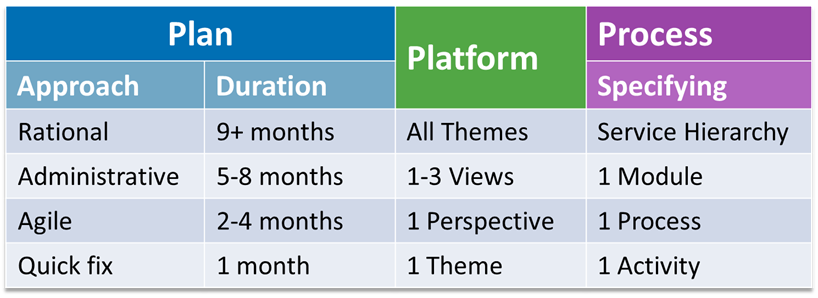
When the Innovation level and subsequently the Planning Approach is determined the other approaches and views in the 4DInemsions™ Transformation Framework can be defined. The matrix can also be used with input in the other dimensions.
After the sprint
The last part of a sprint is the Transition of the Services into the Operational Organisation. To ease the transition, some of the participants in the transformation team can be transferred into the new positions that emerge due to the transformation. This will bridge the knowledge gap, and at the same time the change initiatives will serve as training a career development platform for ambitious staff.
Training Discipline
The purpose of the training is to ensure that the participants in the business transformation have adequate training, education and skills within the areas that may be impacted by the business transformation.
Project Management is nearly the only formalised and generally accepted training in change management in the businesses. Project Management education is mainly focused on the IT department and on the governance of the Project Process. However, a few Business Project Managers are educated in the same methodologies.
Currently, there is no formal business training in setting up the Business Transformation. This competence area has always been outsourced to large and costly Management Consulting Companies – whose method to the outside world is still a well-kept secret!
In these circumstances, Senior Management plays a key role. Senior Management sets ambitious goals and then also expects fast results. This results in the frequent omission of training and misalignment between the participants, which in the long run results in coordination challenges and poor results.
To establish a common vocabulary and a collective understanding of methods and tools it will be necessary to train part of the business organisation as well as the IT organisation, that participate in the transformation.
Training of the organisation
A key mission of this book (Disruption and Digital Transformation) is to create a collective understanding of dynamics of a business; i.e. when you change one Theme, there may be changes to other Themes too.
In general, staff is poorly trained in an organisation’s objectives and the change method being used. This causes poorly prepared meetings with constant discussions of objectives. Also, there are discussions about prerequisites, about facts and how to exchange and integrating knowledge and how to find and archive documentation.
Implementing the 4Dimensions™ Transformation Framework to its full extent will require massive training for all the participants in the Transformation Organisation. But as it is shown in the description of the Optimise Discipline it is possible to have a gradual implementation.
Most of the staff will need a fundamental understanding of the dynamics from an organisational perspective and delivery perspective.
Management will need a solid understanding of the Platform Dimension and a general understanding of the Planning Dimension.
The Subject Matter Experts and Project Managers will need an in-depth understanding of the Planning Dimension and a good understanding of the Platform Dimension.
The Change Manager or a Project Manager must be an expert and proficient in the complete framework.
| Board | The Board of Directors appointed by the organisations owners to define the overall mission and to hire the Senior Executive Management |
| Executive | The Top Management must know the vocabulary, the digital strategy, the reason for failure, the 6 Principles for success and the Platform Dimension. |
| Governance | The Management must be proficient in the Principles for Success and the Platform Dimension and must know the Planning, People and Process Dimensions. |
| Change Management | The Change Management know the Principles for Success and must be proficient in the Platform, Planning, People and Process Dimensions and the associated tools. |
| Line Management | The Change Management know the Principles for Success, the Platform, Planning, People and Process Dimensions. |
| Subject Matter Experts | The project participants must know the Platform, Planning and the Specifying and Tracking Disciplines in the Process Dimension. The participants must also know the tools. |
Additional Training
If the transformation involves acquisition or implementation of Business or IT platforms, it has proven crucial for the progress and quality of the transformation that the participants receive thorough training in the platforms up front. This will accommodate the Design Thinking philosophy.
Specifying Discipline
The key for executing a change is a clear understanding of the requirements. Disagreement on the requirements will never result in a successful project.
The objective of the Specifying Discipline is to generate requirements to the assets and to identify the actions needed for transforming the assets.
Specify the Changes
The tool for specifying a change to an asset is the Change Sheet.
Initially the assets in the Platform Dimension needs to be described. Ideally you will start outside in with the Mission View. But the other Approaches are also feasible – dependent on the context of the actual situation.
- Identify the to-be condition of the theme (ex. an asset)
- Identify the as-is condition of the theme (ex. an asset)
- Identify the actions to get from as-is to to-be
- Quantify how assets can be measured (i.e. the success factor)
- Describe the current measurements
- Describe the assumptions, dependencies and risks connected to achieving the
to-be
Specify the Service Hierarchy
Processes-based requirement creation is a method for breaking down the Business Algorithm into detailed tasks. The tasks can either be executed by people or technology. If a project contains a substantial portion of Information Technology, it is called an IT project. Most disruptive changes have large components of IT.
When working with IT projects, the human side of work is commonly forgotten. In this way, the first time it is verified that a business process works will be at the final end-to-end test. By then, it will be too late to fix fundamental issues! The specifications of the IT processes should be described at the same time as the human work (i.e., the Standard Operating Procedure).
The Service Hierarchy is a hierarchical structure that links the overall business model and mission with the tasks executed by customers, partners, subcontractors and the business itself.
The content of the procedures will provide the User Requirement Specification (URS) and the attached Functional Solution Description (FSD) for developing IT Systems. The requirements at the lowest level will be the change sheets for the tasks (this is the process steps at the lowest level),
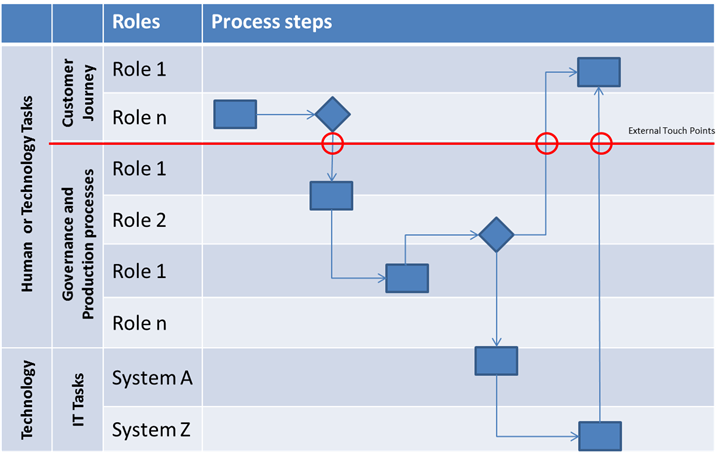
Requirements
The Specifying Theme will turn the swim lanes that are produced by Process Dimension’s Specifying Discipline into firm specifications, creating Standard Operating Procedures for human work, functional and non-functional design specifications for the IT systems.
The functional requirements to IT will be associated with the Algorithm View, whereas the non-functional requirements will be generated from the other views in the Platform Dimension.
Tracking Discipline
The purpose of the Tracking Discipline is to create a clear line of sight between the overall objectives (i.e. the mission) of the transformation and the services to be delivered by the business. There must be two-way traceability! It will ensure that the work packages to be executed by the projects can be mapped to the overall scope and strategy of the business transformation.
From Mission to Business Platform
The foundation for describing the business platform is the business’s mission. It is infused by the Mission View. From here the Business’s Platform is described by the interaction of the Assets (Themes). The end objective is for the transformation is to deliver the Services to the market (via the Customer Journey).
We could set another theme as the end objective, but the Process Oriented Change Execution has proven to be extremely effective.
The Specification Discipline delivers scope of each of the Assets. The Tracking Discipline describes the relation (business dynamics) between the Services and all the other Assets.
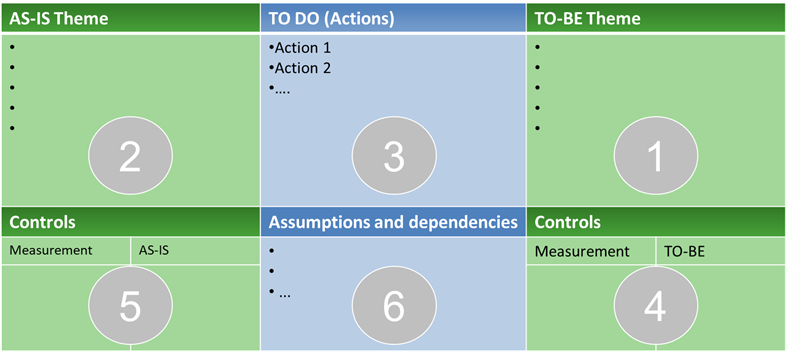
It has previous been demonstrated that the Services form a hierarchy of services. Similarly, the remaining Assets can be hierarchical structures. For example, it is useful to breakdown the Infrastructure into the components in the IT Architecture. In this way both rows in Platform Matrix can be expanded and collapsed.
The gap and Actions to transform the Assets are described through the Change Sheets for the cells in the Platform Matrix. The Change Sheets can be used high-level when the Platform Matrix is collapsed and at a detailed level when the Platform Matrix is expanded. The Change Sheets can be named by their position in the Platform Matrix.
The matrix is simplified by identifying the Minimal Viable Services for the actual sprint using the winning sheet.
From Business Platform to Planning Actions
The Planning Dimension contains further action needed for transforming the Business Platform. The Actions needed to create the new services is defined by the Action Matrix. Here the Services from the Business Platform are mapped to the Planning Actions.
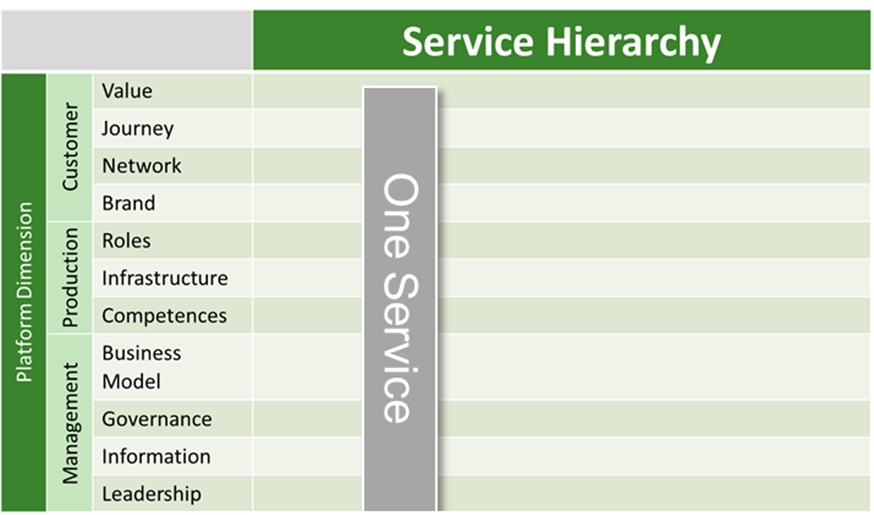
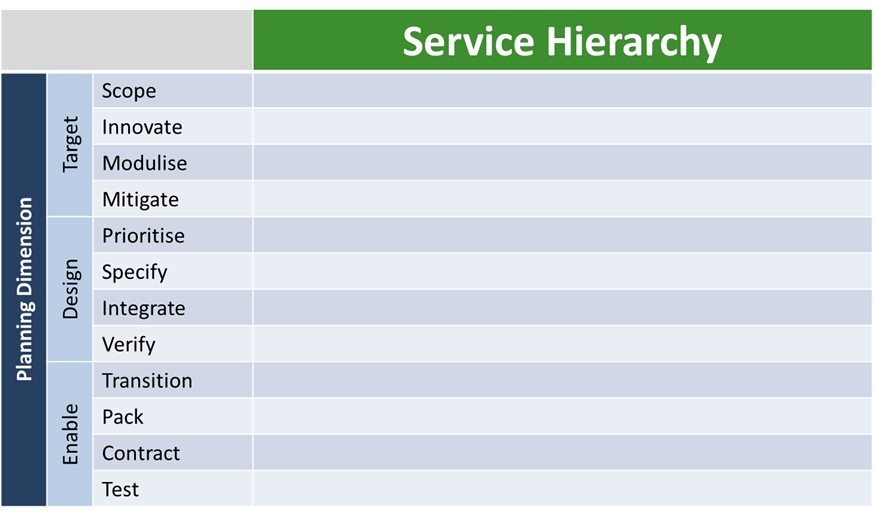
From Actions to Change Initiatives for the Sprint
When the actions needed for the transformation are identified, these should be grouped into Change Initiatives to make them operational.
| A Change Initiative is a practical grouping of Actions that will facilitate their realisation in a sprint. |
The Platform Matrix contains the Actions needed to realise functional and non-functional (from the Brand Theme) requirements, and the Plan Matrix contains the Transformation Governance Actions.
From Initiatives to Competences and Staffing
Each of the Actions generated from the Change Sheets from the Minimal Viable Services from the Platform Dimension and the Actions needed to define the transformation requires specialised competences. These are mapped to the People Dimensions Competences. This leads to the People Matrix.
The logic of the Specifying and Tracking Disciplines is described as follows:
The purpose of the Optimising Discipline is to reuse the Actions from previous transformations and changes. Obviously, there is different output of the Actions, but as long the participants can repeat the process, there will be significant gain in efficiency of the transformation. Also, the onboarding of the participant will be much easier because all unchanged themes can be copy/pasted. Finally, it is much easier to modify a description of an action than to create it from scratch.
The prerequisite for reuse is, that as much as possible of the structure from previous changes are preserved.
First it will be the Service Hierarchy (in the columns), as this is the key entrance action framework.
Secondly, as much as possible of the breakdown of the Platform and Planning Themes must be retained. Experience shows, that there will be fewer new actions to be executed in a part of the matrix.
Third the Actions must be identified by their position (row and column) in the matrices.
Fourth, the transformation team must be retained to maintain knowledge on pitfalls and smart ideas in the team. However, some new people in the team will help to spread learning and the diversity may also create inspiration to further improvements.
As more and more employees and consultants are certified in the 4Dimensions™ Transformation Framework, it will be easier to onboard trained staff internally as well as external consultants.
© 2018 4dimensions.info
